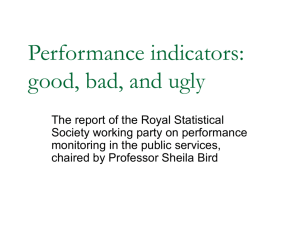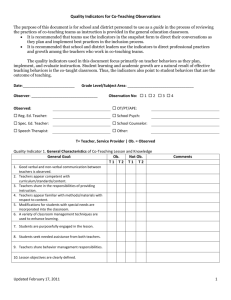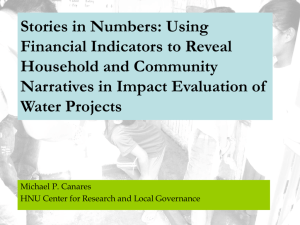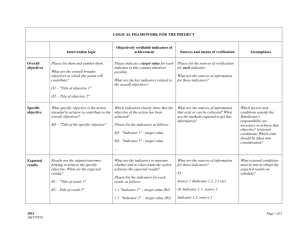Agricultural Sustainability Indicators: a Global and Developing
advertisement
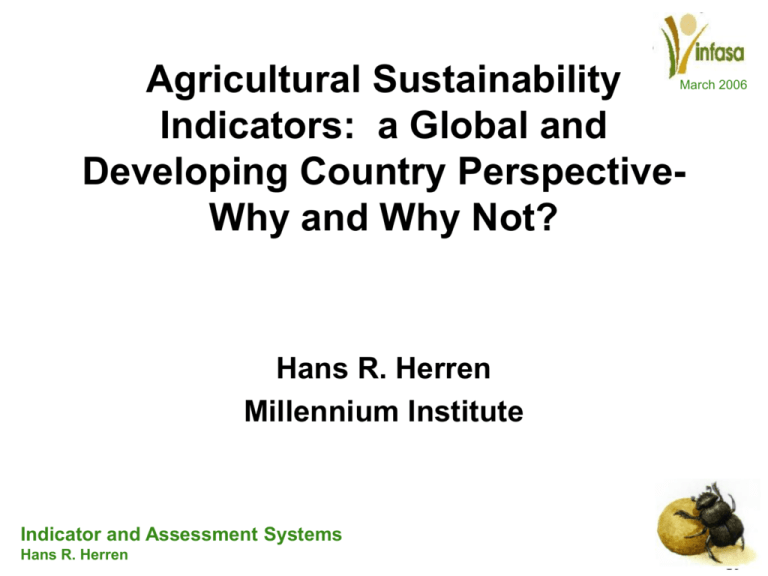
Agricultural Sustainability Indicators: a Global and Developing Country PerspectiveWhy and Why Not? March 2006 Hans R. Herren Millennium Institute Indicator and Assessment Systems Hans R. Herren Keynote Overview 1. Why indicators? 2. The nature of indicators 3. The process of sustainability assessment 4. Why not indicators: issues & challenges for developing countries 5. Possible framework for indicator development 6. Conclusion Indicator and Assessment Systems Hans R. Herren March 2006 March 2006 What is Agricultural Sustainability? (Little need to review the many diverse definitions of sustainability since the 1972 Earth Summit) Farming that makes best use of nature’s goods and services while not damaging the environment. Indicator and Assessment Systems Hans R. Herren 1. Why indicators? March 2006 • Agricultural sustainability is a must if we want to be able to produce food for the generations ahead • Agricultural sustainability is complex and needs to cover the whole food chain, from production to consumption • Knowing and tracking indicators provides an opportunity for the concerned public to follow this food chain, and its trends toward or away from sustainability. …but the chains has major disconnects at three levels….. Indicator and Assessment Systems Hans R. Herren 1. Why indicators? March 2006 The Status of the Agricultural Production Base; characterized by disconnects, both the in developed and developing world: A. Disconnects between agriculture and the environment; B. Disconnects between producers and consumers or land and cities; C. Disconnects between policies and expectations. Indicator and Assessment Systems Hans R. Herren 1. Why indicators? March 2006 A. Disconnects between agriculture and the environment Contemporary agriculture = managing land in ways that conflict with the healthy functioning of ecosystems (level fields, reductions of biodiversity, no rest period, use of toxic chemicals, etc.) Yet agriculture depends on the healthy functioning of ecosystems: -water supply, -cycling of nutrients in soils, -pollination, -pest control Indicator and Assessment Systems Hans R. Herren 1. Why indicators? A. . Disconnects between agriculture and the environment con’t Human activities have significantly disturbed water, carbon and nitrogen cycles and so are impacting global climate change, which in turn is and will impact agricultural productivity and challenge sustainability Contemporary farming methods have degraded soil leading to massive fertilizer use. Indicator and Assessment Systems Hans R. Herren March 2006 1. Why indicators? B. Disconnects between producers and consumers or land and cities Perpetual low prices that consumers are generally willing to pay for food (making farming a precarious business), is now compounded by a crisis of trust amongst consumers, fueled by food scares (Mad Cow, Asian Bird Flu) and a sense that many supermarket foods are low on nutritional value, high on price. Indicator and Assessment Systems Hans R. Herren March 2006 1. Why indicators? C. Disconnects between policies and expectations. March 2006 Almost every country in the world cherishes its agricultural roots, ..in song, picture and mythology. But this valuation is rarely translated into policy to support the family farms that are central to an agricultural community. Indicator and Assessment Systems Hans R. Herren 1. Why indicators? March 2006 There are multiple motivations to use/collect indicators of agricultural sustainability, although few apply to developing countries: • To monitor impacts of policy (few developing countries want this information collected); • Because consumers demand this information (weak consumer movement); • Because an environmental movement demands this information (weak environmental movement); • Because an enlightened private sector wants this information (weak private sector). Indicator and Assessment Systems Hans R. Herren 1. Why indicators? But changes are underfoot: March 2006 • Increased demands for accountability by citizens and donors; • Consumers are becoming more discriminating; more food is being purchased in conventional retail outlets and supermarkets; • Growing sophistication of NGOs; • Export private sector is demanding standards and certification. Herein lies a risk, that these forces “driving” the assessment of agricultural sustainability are somewhat external to the system… Indicator and Assessment Systems Hans R. Herren 2. The nature of indicators March 2006 Indicators: • Are natural and everywhere • Arise from values and create values • Poorly chosen, they cause serious malfunctions • Their choice is a critical determinant of the behavior of a system (D. Meadows 98) Indicator and Assessment Systems Hans R. Herren 2. The nature of indicators March 2006 For sustainability indicators, time is an important element. But since long term monitoring takes more time and resources than are usually available, need surrogates for sustainability and time (for example, soil nutrient levels may indicate if soil has being well cared for in the past, or mined). Indicator and Assessment Systems Hans R. Herren 2. The nature of indicators March 2006 Purposes/utility includes: • • • • • Management tools Research Tools Educational and motivational use Project assessment Planning and policy instruments Indicator and Assessment Systems Hans R. Herren 2. The nature of indicators March 2006 Ideally, indicators should be simple and well understood (as with body temperature and health) Unlikely that sustainable agriculture can be captured in one simple indicator. ? Should sustainable agriculture indicators be made up of: • One combined indicators (may be highly influenced by what is included) -or• A set of indicators (people are unlikely to study a whole set, many audiences only have time for a simple index) In either case, raw data used to derive indicators MUST be open and available to those who wish to examine the subsequent process of data treatment. Indicator and Assessment Systems Hans R. Herren 2. The nature of indicators Types of Indicators: • Pressure (or stress) • State (or composition) • Response • Why • How • What • Past • Present • Future Indicator and Assessment Systems Hans R. Herren March 2006 2. The nature of indicators An example • Pressure (or stress), why, past: the rate of extraction of groundwater • State (or composition), how, present: the current level of groundwater • Response, what, future: what is being done to mitigate over-extraction All three are needed to tell the complete story! (G. VanLoon et al, 2005) Indicator and Assessment Systems Hans R. Herren March 2006 2. The nature of indicators March 2006 Another important typology of indicators: (none of these alone can give the complete picture; sustainability should always be considered in light of these three legs) 1. Environmental 2. Economic 3. Social Indicator and Assessment Systems Hans R. Herren 3. Process of sustainability assessment March 2006 A. Agricultural sustainability must be defined by stakeholders. The identification of stakeholders, in turn, QuickTime™ and a TIFF (Uncompressed) decompressor are needed to see this picture. is determined by the boundaries of the system. QuickTime™ and a TIFF (Uncompressed) decompressor are needed to see this picture. Indicator and Assessment Systems Hans R. Herren 3. Process of sustainability assessment March 2006 A. con’t. Narrow definition of Agricultural production systems (fields and farms) Wider production systems (included food and nonfood -biofuel, pharma, flowers, carbonsequestration systems, and the production chain to consumers) …the drivers for sustainability assessment include investors, private sector and consumers..this boundary is more appropriate. Indicator and Assessment Systems Hans R. Herren 3. Process of sustainability assessment March 2006 A. con’t. The broader stakeholder group should define sustainability, and appropriate goals /targets. QuickTime™ and a TIFF (Uncompressed) decompressor are needed to see this picture. QuickTime™ and a TIFF (Uncompressed) decompressor are needed to see this picture. Indicator and Assessment Systems Hans R. Herren 3. Process of sustainability assessment March 2006 B. Research and stakeholder dialogue should identify the criteria and indicators of sustainability goals C. Data on indicators should be collected to show progress toward sustainability goals, and this shared with policy makers Indicator and Assessment Systems Hans R. Herren 3. Process of sustainability assessment March 2006 D. Policy makers should make decisions and policies to reorient toward greater sustainability, based on assessment and research findings. E. Policies must be implemented and enforced (governance issues) Indicator and Assessment Systems Hans R. Herren 4. Issues and Challenges to Design Indicators for the Developing Countries Life Cycle materials: Food system mass flow The complexity of system boundaries in a developed country, as a point of comparison…Inp uts and outputs to agriculture in the United States Indicator and Assessment Systems Hans R. Herren March 2006 4. Issues and Challenges to Design Indicators for the Developing Countries Comparison with Kenya Life Cycle materials: Food system mass flow Export animals Indicator and Assessment Systems Hans R. Herren March 2006 5. Possible Framework for Developing Indicators, Using Kenya and the US as Test Cases March 2006 Stakeholders: Farmers, breeders, seed companies Life cycle stage: Origin of resource -seed or production breeding KENYA economic degree of farmer control over seed/breed indicators social diversity in seed purchasing and seed collecting 80% of seeds are farmer seedbut they are often low-yielding farmers have access to a wide 56% of maize planted in Kenya is diversity of land races and local breeds hybrid maize environment ratio of naturally pollinated to hybrid seed US economic degree of farmer control over seed/breed 100% of seeds are commercial; high yielding but require high inuts indicators social diversity in seed purchasing and seed collecting farmers have no access to diversity of seeds and breeds 100% of maize is hybrid (modified after M.C. Heller & G.A. Keoleian, 2000) Indicator and Assessment Systems Hans R. Herren environment ratio of naturally pollinated to hybrid seed 5. Possible Framework for Developing Indicators, Using Kenya and the US as Test Cases March 2006 Stakeholders: Farmers, farm workers, ag industry, gov, animals Life cycle stage: Production KENYA economic return on investment; farmer savings; employment; level of government support off-farm income is often key to prosperity, ability to invest onfarm and savings; little government support environment rate of conversion of land to Ø age of farmers, size of farms, active agriculture, rate of soil loss, agrarian community, time animals chemical pollution, pest and spend outdoors disease losses Ø age of farmers is 37; Ø farm size is less than two hectares; agrarian communities are very active and forests being "grabbed" illegally, important to Kenyans, animals spend 13 tons per hectare per year; most of their time, if not 100% out of rising levels of chemical pollution, doors v. large pest and disease losses Indicator and Assessment Systems Hans R. Herren indicators social 5. Possible Framework for Developing Indicators, Using Kenya and the US as Test Cases March 2006 Stakeholders: Farmers, farm workers, ag industry, government Life cycle stage: Production US economic return on investment; farmer savings; employment; level of government support 84% of farm household income is earned off-farm; 48% of farms report a net loss; government support is mixed indicators social environment Ø age of farmers, size of farms, active rate of land conversion, rate of agrarian community, time animals soil loss, chemical pollution, pest spend outdoors and disease losses Ø age of farmers is 55; Ø farm size is 443 acres; more people live in cities than in rural areas, animals often confined Indicator and Assessment Systems Hans R. Herren agricultural land is rapidly being converted to urban land, 90% of US farms are losing soil above the sustainability rate but not as high as Asia, Africa and Latin America; pesticide use slowly going down while herbicide use going up, 5. Possible Framework for Developing Indicators, Using Kenya and the US as Test Cases March 2006 Stakeholders: Consumers, health professionals Life cycle stage: consumption Kenya indicators social economic environment portion of consumer income spent on food rates of malnutrition; rates of obesity; energy use in preparation, waste, healthiness of diet; product quality recycling 31% of income spent on food ( but in many places, more than 50% are below the poverty line) average rates of stunting, wasting and underweight among children in 8 little energy use in preparation, districts are 37%, 6% and 27% little waste US indicators social economic portion of consumer income spent on food Marketing is 80% of food bill; Industry consolidation threatenes market competition rates of malnutrition; rates of obesity; energy use in preparation, waste, healthiness of diet; product quality recycling 73 units of energy used to produce 1 unit of food; 26% of obesity rates rising edible food wasted Indicator and Assessment Systems Hans R. Herren environment 6. Conclusion March 2006 • Agricultural sustainability will make measurable progress only with a set of reliable and representative indicators that reflect a holistic view of the food system, rather than just the production component • Serious research and stakeholder consultations will have to take place to design and develop indicators that are based on good science and stakeholder consensus • In addition to the above, awareness and human resource capacity will have to be developed • One should also make sure to fully assess the risks and benefits of using indicators Indicator and Assessment Systems Hans R. Herren March 2006 You cannot solve the problem with the same kind of thinking that created the problem Albert Einstein Thank you….. Indicator and Assessment Systems Hans R. Herren


